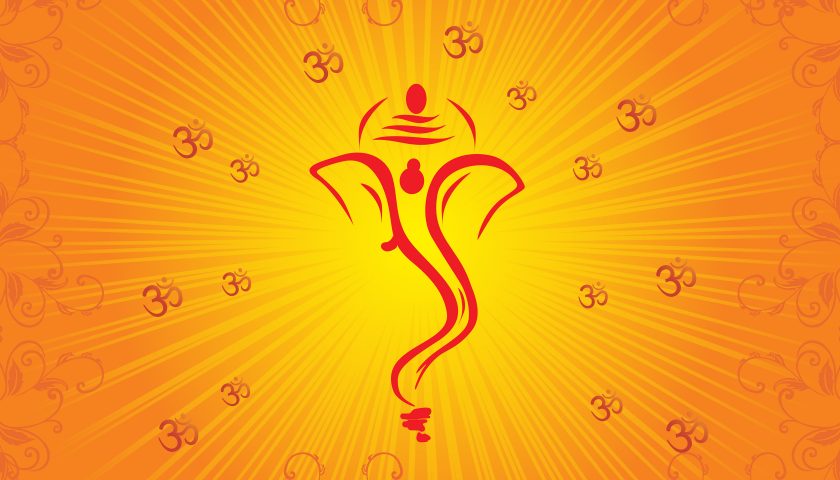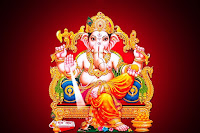जय श्रीगणेशा
The Term “Veda”(वेद) is translated as “Knowledge” or “To Know”. The “Vedas” were never written down earlier and the first written version of “Vedas” originated about 2000 BC
Similarly, the holy Upanishads (उपनिषद) which is actually translated to “Knowledge which is obtained Sitting near the Guru” which derive the esoteric meanings or the deep rooted philosophies of the “Vedas”(वेद) were created during 600 to 700 BC
However “The Greatest of All Teachers” – “Shri Krishna” (श्री कृष्ण ) Himself , laid down the Teachings of the divine Vedas in “The Shrimad Bhagvad Geeta”(श्रीमद भगवद् गीता ) to The Greatest Disciple “Arjuna” (अर्जुन) during the great war of “Mahabharata”(महाभारत) in the form of poetic verses in simple to understand form for everyone and till today is the most sacred and divine book for anyone who wants to understand “Dharma”(धर्म )
“Shlokas”(श्लोक) are verses, praises of the Divine which can be chanted by anyone, at anytime. They are meant to inspire towards contemplation of the Supreme.
“Shlokas”(श्लोक) are different from “Mantras”(मन्त्र) which are an invocation or a set of sounds to invoke certain powers to the person chanting the “Mantra”(मन्त्र) or the people listening to the same. (They should be chanted at proper time and place and full attention to achieve the desired effect)
“Sri Krishna”(श्री कृष्ण) in his teachings has provided the holistic understanding of “Vedas” and has laid down path of “Dharma”(धर्म) or “Righteousness” in very simplistic yet profound principles through the process of “Samvada” (संवाद) or in the form of a conversation where “Arjuna” poses his questions and the Lord answers
In this divine poem, “Sri Krishna” (श्री कृष्ण ) clarified to “Arjuna” (अर्जुन ) about the need to discharge one’s “Duty” called “Swadharma” (स्वधर्म ) and explained the path of “Karma Yoga”(कर्म योग) through which one must perform one’s prescribed “Karma”(कर्म ) or “Actions” without having any sense of attachment to the fruits of one’s actions and doing the same unselfishly.
He also explained about the “Soul” or “Aatmaa”(आत्मा) being “Eternal” whereas the Body which carries the “Soul” and the “Mind” which provides Direction are transitory and are governed by the senses through the “Sense Organs” and are thus always in “Maayaa”(माया ) or “Illusion”
He has explained about the “Trayo Guna” (त्रयो गुण ) and the “Pancha Bhoota”(पञ्च भूत) and has explained about how the “Gunas” (गुण ) give rise to human emotions and thus in extremes can give rise to destructive traits like anger, arrogance, lust,jealousy and greed which are the cause of all evils in this world.
In his words, Every Human Being must transcend the traits of “Maayaa”(माया ) and lead the path which leads to one’s Soul ( Jeevatma or जीवात्मा ) or one’s True Self and in process achieve the state of “Divine Consciousness and Bliss” which is the path to realisation of “GOD” or “Paramatma” (परमात्मा)
“Sri Krishna”(श्री कृष्ण) in one of the verses of the Song, described himself as the Creator of the “Vedas” and he passing the knowledge to “Lord Brahma” and then to the Ancient “Rishis”(ऋषि) and referred to himself as “GOD Himself or his Incarnation” and being questioned by “Arjuna” as to how he was present so many generations back when he was being born in the present generation, he further clarified that “Both He and Arjuna have taken many forms of life and incarnations and although Arjuna has forgotten them being unaware of his “Soul”, He ( being GOD Himself) was aware of his all his previous births through the awareness of the “Divine Soul” or “Paramatma”(परमात्मा) and not being engulfed in “Maayaa”(माया) or “Illusion”
He thus clarified “The Soul being Immortal and All Pervading” in this famous verse as given below;
“नैनं छिन्दन्ति शस्त्राणि नैनं दहति पावकः । न चैनं क्लेदयन्त्यापो न शोषयति मारुतः ॥”
लोकेऽस्मिन्द्विविधा निष्ठा पुरा प्रोक्ता मयानघ।
ज्ञानयोगेन सांख्यानां कर्मयोगेन योगिनाम्।।3.3।।
“Sri Bhagawaan Speaks:”
O Arjuna, two kinds of steadfastness in this world were spoken of by Me since the ancient times -through the Yoga of Knowledge for the men of realisation; through the Yoga of Action for the yogis.
In this above verse “Sri Krishna” ( श्री कृष्ण ) explains the two divine paths of “Yoga” ( योग )where one of the path which can be taken by the “Seekers” who are in the pursuit of “Divine Knowledge” which is called “Gyana or Jnayana” (ज्ञान) Yoga. A “Seeker” or “Sankhya” takes the path of “Self Realization and Enlightenment” and becomes and Enlightened Soul. These Souls are not connected to the Illusory World of “Maayaa” ( माया ) and thus are disconnected from the same and thus they don’t perform any “Action” or “Karma”(कर्म )
“Sri Gautama Buddha”(श्री गौतम बुद्ध ) was one such Enlightened and “Divine Soul” and he shunned his Royal Life of that of a Prince to become a “Monk“or “Sanyasi“(सन्यासी)
However, there is another type of “Yoga” called “Karma Yoga“(कर्म योग) which is the “Yoga of Action” which “Lord Krishna The Divine“(परमात्मा श्री कृष्ण ) has given higher value compared to “Gyana or Jnayana Yoga“(ज्ञान योग). It is because, the “Creation” or “Shrishti”(श्रिष्टि) will cease to exist through Inaction and “Actions” or “Karma”(कर्म ) must be performed so that the Creation or “Shrishti” continues
“Sri Krishna”(श्री कृष्ण ) in this “Everlasting and Divine Song” has also explained about the way to lead the path of “Action” or “Karma Yoga”(कर्म योग ) through the process of performing “Selfless or Dispassionate Actions”
Before that, he has also explained about “Maayaa”(माया) or “Guna”(गुण) and he has explained the “Forces of Nature”,”The Guna” (त्रयो गुण ) and how to transcend them in a few beautiful verses some of which are as follows:
“त्रैगुण्यविषया वेद निस्त्रैगुण्यो भवार्जुन |
निर्द्वन्द्वो नित्यसत्त्वस्थो निर्योगक्षेम आत्मव(न् ||”
In the above verse, “Sri Krishna“(श्री कृष्ण ) explains thus :
“The “Three Gunas”(त्रयो गुण ) are the main components within which the circumference of which “The Divine Vedas” (वेद) analyse life. “O Arjuna(अर्जुन)” you must transcend them. Fix your mind on the ultimate “Truth“(सत्य) and be free from the concerns of the material world. Always Concentrate on the “Self or Aatmaa”(आत्मा)”
“योगस्थः कुरु कर्माणि सङ्गं त्यक्त्वा धनंजयः |
सिद्ध्यसिद्धयोः समो भूत्वा समत्वं योगं उच्यते ||”
In the above verse, “Sri Krishna“(श्री कृष्ण ) explains thus :
“Mind fixed on Duty and all thoughts and about the fruits of your action abandoned; such equanimity of mind is the essence of “Yoga”, O winner of wealth”
“Sri Krishna” ( श्री कृष्ण ) in one of the Greatest Verses of “Geeta” ( Verse # 47 in the 2nd Adhyaya (अध्याय ) ) explains the concept of “Nishkama Karma“(निष्काम कर्म) or the concept of performing “Selfless or Dispassionate Actions”:
“कर्मण्येवाधिकरस्ते मा फलेषु कदाचन |
मा कर्मपहलहेतुर्भूर्मा ते सङ्गोस्त्वकर्मणि “
In the above verse, “Sri Krishna“(श्री कृष्ण ) explains thus :
“O Arjuna (अर्जुन), Having acquired the state of a warrior, you are now eligible to act in whatever way the stature of a warrior demands of you. But you are not entitled to any benefits resulting from your actions. At the same time having the responsibility of that of a warrior you are not entitled to a state of not acting all.
Thus you should act according to your stature without any hope of enjoying the fruits of your actions”
In the above verse, “Sri Krishna“(श्री कृष्ण) in his beautiful words has explained the purpose of every living soul who wants to engage in the “Yoga of Action” or “Karma Yoga”(कर्म योग). In very simple words he has thus laid down thus that although one needs to act all the time being part of this World or “Creation” (श्रिष्टि) but at the same time one must do the action dispassionately without having any sense of attachment or desire towards the fruit of the same.
In another Verse, “Sri Krishna“(श्री कृष्ण ) explains about the value and need of performing “Action” or “Karma“(कर्म) and he explained although he did not have any need of performing any “Karma” yet the “Creation” cannot survive if he is stops performing “Action” and thus “He” is obliged to do so to “Sustain” the creation in this “World”
“न मे पार्थास्ति कर्तव्यम् त्रिषु लोकेषु किञ्चन |
नानवाप्तमवाप्तव्यं वर्त एव च कर्मणि ||
“O Son of Pritha ( Partha), though there is no action, that I need to complete in all three worlds I still do my duties”
“He” further goes on to say
“यदि ह्यहं न वर्तेयं जातु कर्मन्यतंद्रितः |
मम वर्त्मानुवर्तन्ते मनुष्य पार्थ सर्वसः ||”
“For If I fail to engage myself in proper action, with great care, “O Partha”, people would follow my footsteps and act like me”
“Sri Krishna”(श्रीकृष्ण ) in many of the verses spoke about “Himself” or “The Paramatma“(परमात्मा) and what is the purpose of “His” birth in the Earth or “Prithvi“(पृथ्वी )
“श्री भगवान ऊवाच – इमं विवस्वते योगं फ्रोक्तवानहमब्ययम् |
विवस्वान्मनवे प्राह मनुरिश्वक्वेअब्रवीत् || “
“Lord Krishna said: I explained this eternal science of “Yoga”(योग) to Rishi (ऋषि) “Vivaswaan”(विवस्वान) and then it has been passed over many “Ages” to Rishi “Manu”(मनु) and then imparted to “Iksvaaku”(इक्ष्वाकु)
On being questioned by “Arjuna” that how “Sri Krishna” taught this science to “Vivaswaan”(विवस्वान) when “He” was born long after him, to this the “Lord” explained in the beautiful verses narrated below:
“श्री भगवान उवाच – बहुनि मे व्यतीतानि जन्मानि तव अर्जुन |
तान्यहं वेद सर्वाणि न त्वं वेत्थ परंतप || “
“Lord Krishna said: Arjuna, both you and I have had many births. I remember all of them, whereas you have forgotten the same”
त्यक्त्वा देहं पुनर्जन्म नैति ममेति सो अर्जुन ||
जयश्री राम
References:
https://www.speakingtree.in/allslides/nainam-chindanti-sastrani-nainam-dahati-pavakah-571436
https://www.quora.com/What-is-Yoga-as-described-by-Krishna-in-Geeta
Srimad Bhagavad Gita publication by “Srinivas Arts pvt ltd, Sivakashi, Tamil Nadu”


Greetings! Very helpful advice within this post! Its the little changes that make the greatest changes. Thanks a lot for sharing!